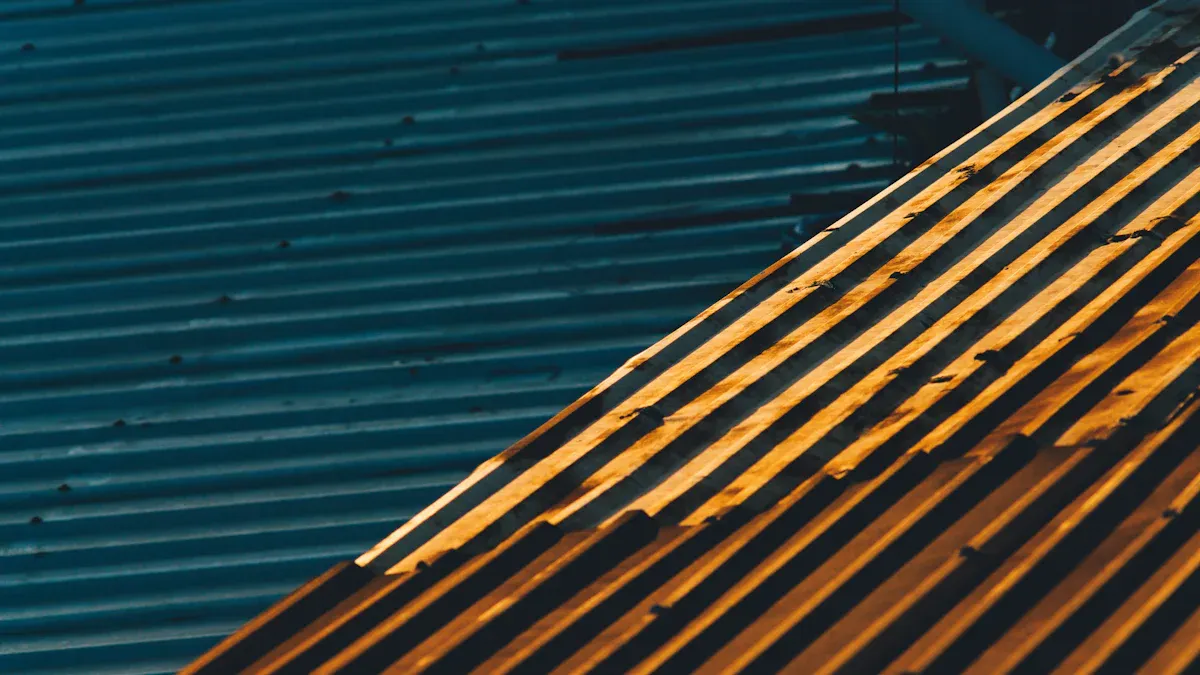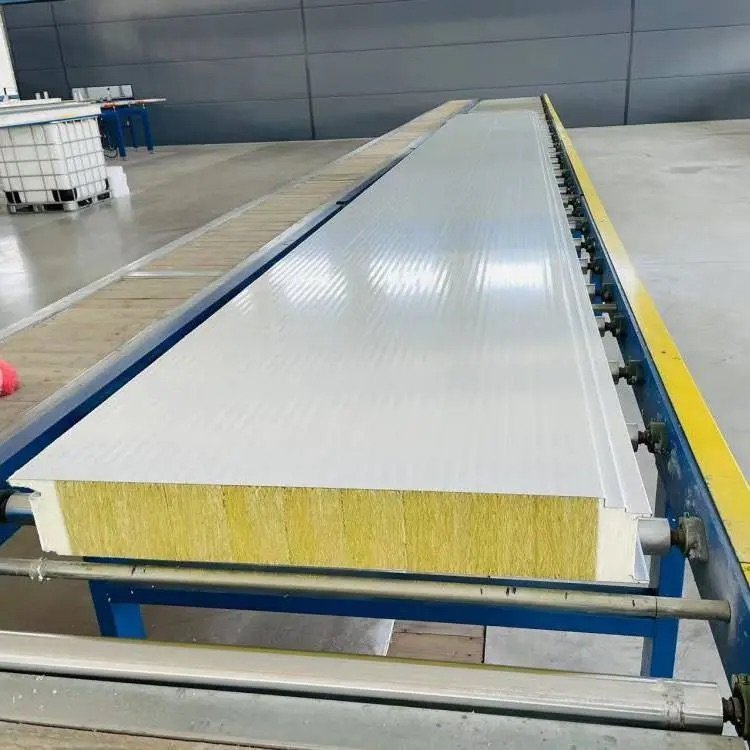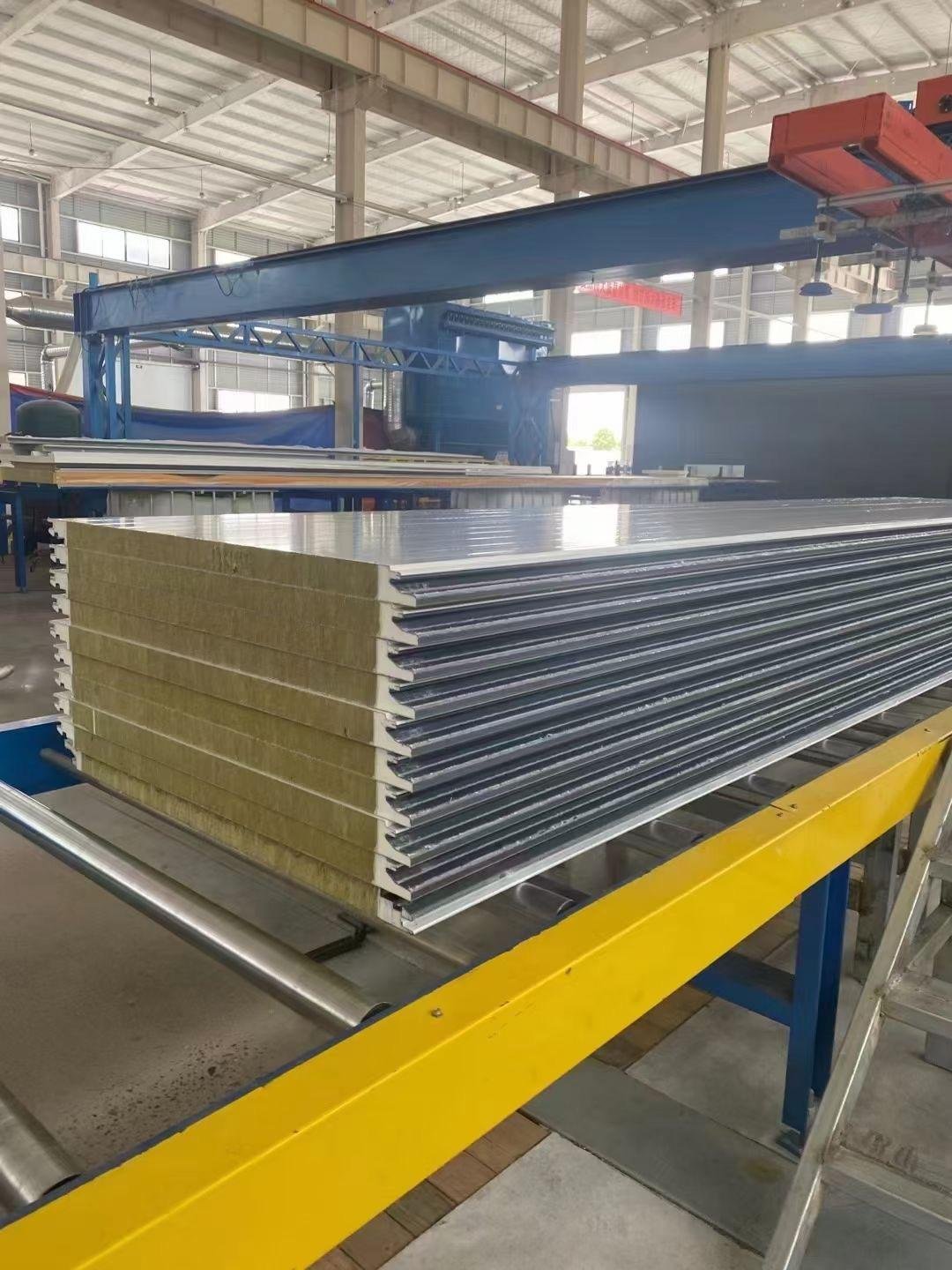
Fire-rated sandwich panels are important in today’s building projects. These panels are made to resist fire and follow safety rules. They can handle high heat, protecting buildings and people inside. For instance, a 75mm thick panel can resist fire for three hours. This is much longer than the one-hour national standard. Such fire resistance is very important in places like stores or offices. These areas can have a fire load of 747 MJ m−2. Using fire-rated panels makes buildings safer and lowers risks and damages.
Key Takeaways
Fire-rated sandwich panels keep buildings safe by slowing down fires.
Picking the right core, like mineral wool or PIR, is key for fire safety.
Knowing fire ratings helps you choose panels that meet safety rules.
Talking to fire safety experts ensures you follow local laws and stay safe.
Fire-rated panels save money over time by cutting energy costs and fire damage.
Understanding Fire Resistance of Sandwich Panels

What Does Fire Resistance Mean?
Fire resistance shows how well a material handles heat and stops fire. Fire-resistant sandwich panels can face heat without melting or breaking apart. These panels help slow flames and reduce damage to buildings. For example, they go through strict tests like EN 1364-1 to check their strength. Tests measure heat rise, strength, and bending based on panel thickness. This ensures the panels meet safety rules and work well against fire.
These panels are great because they don’t catch fire easily. They can also stop burning when the fire dies down. Materials like rock wool insulation make them good for hot places like factories. Using these panels makes buildings safer and protects people inside.
Importance of Fire Resistance in Construction
Fire resistance is very important in building design today. Modern buildings face more fire risks due to flammable materials. For example, flashover, where fire spreads fast, happens in 5 minutes now. In older rooms, it took 29 minutes. Open spaces and big windows also make fires spread faster.
Fire-rated sandwich panels help solve these problems. They are safer and cheaper than older materials. Their fire resistance makes them perfect for factories, offices, and homes. Adding fire-resistant materials lowers damage risks and follows safety laws.
Evidence Type | Description |
|---|---|
Fire Hazard Challenges | Modern buildings have more fire risks from fuel loads. |
Flashover Timing | Flashover happens in 5 minutes now, not 29 minutes. |
Architectural Design Issues | Open spaces and big windows spread fire faster. |
Fire Reaction Classification for Sandwich Panels
Fire reaction classification shows how panels act during a fire. It checks fire spread, smoke, and burning drops. Ratings go from A (best) to F (worst) for fire spread. Smoke is rated S1 (low) to S3 (high). Droplets are rated d0 (none) to d2 (many). For example, A-S1-d0 panels are the safest choice.
These ratings help you pick the right panels for your needs. The UNE-EN 13501-1: 2019 system explains fire behavior in detail. It rates fire resistance, smoke, and droplets. Knowing these ratings helps you choose panels that fit your building’s safety needs.
Classification System | Criteria Description |
|---|---|
UNE-EN 13501-1: 2019 | Rates fire resistance, smoke, and droplets. |
Contribution to Fire | A (best) to F (worst) for fire performance. |
Smoke Opacity | S1 (low smoke) to S3 (high smoke). |
Droplet Production | d0 (no droplets) to d2 (many droplets). |
By learning about fire classifications, you can pick panels that keep your building safe.
Materials and Features of Fire-Rated Sandwich Panels

Core Materials and Their Fire Resistance
Mineral Wool Core
Mineral wool is a top material for fire-rated panels. It does not burn and stays strong in high heat. This makes it great for fireproof panel insulation. Mineral wool also keeps buildings warm, saving energy while staying safe. It is often used in walls for factories and offices.
Tests show stone wool, a type of mineral wool, stays stable at 300°C. Unlike other materials, it doesn’t melt or release harmful gases in fires. This makes it a safe and trusted choice for fire-rated panels.
PIR Core
PIR (polyisocyanurate) cores are also used in fire-rated panels. They balance fire safety and heat insulation well. When heated, PIR forms a char layer that slows fire spread. This makes it good for walls in homes and offices.
But PIR may need extra fireproofing in risky areas. For example, tests show PIR loses mass at 300°C. Even so, it slows fire spread, making it useful for fire-rated panels.
Core Material | Fire Resistance | Performance | Fireproofing Needed |
|---|---|---|---|
Mineral Wool | High | Excellent | No |
PIR | Moderate | Good | Yes |
Role of Outer Layers in Fire Resistance
The outer layers of fire-rated panels are very important. They are usually made of steel or aluminum, which don’t burn. These layers stop fire from reaching the core. Tests under EN 1364-1 show outer layers affect fire resistance a lot.
For example, panels with steel layers and mineral wool cores resist fire well. But panels with burning outer layers fail as fire barriers. This shows why choosing the right outer material is key for fireproof panels.
Design Features Enhancing Fire Safety
The design of fire-rated panels also matters for fire safety. Features like strong joints and interlocks help stop fire spread. But studies show these alone don’t work in high-risk areas. A good design needs non-burning materials and strong construction.
Evidence Description | Key Insight |
|---|---|
Non-combustible facings with combustible cores fail as fire barriers. | Material choice and design are equally important. |
Mechanical interlocks and steel sheets are inadequate in high-risk areas. | Comprehensive design strategies are necessary. |
By learning about materials and design, you can pick panels that keep your building safe.
Standards and Certifications for Fire-Rated Sandwich Panels
Key Fire Safety Standards
ASTM Standards
ASTM standards are important for fire-rated sandwich panels. They explain how to test and check fire resistance. For example, ASTM E84 checks how materials burn on the surface. ASTM E119 tests how well building parts resist fire. Following these rules ensures panels are safe for construction use.
EN 13501 Classification
EN 13501 is a European system for testing fire behavior. It rates materials on fire reaction, smoke, and burning drops. For example, A2-S1-d0 panels burn less, make little smoke, and no drops. This helps you pick panels that meet safety codes for your building.
Standard | Description |
|---|---|
Tests fire performance of sandwich panels. | |
Rates fire behavior of construction materials. | |
EN 13823:2020 | Tests fire reaction to a single burning object. |
UNE-EN 14509:2014 | Sets rules for insulated metal sandwich panels. |
UNE-EN 13823:2012 + A1:2016 | Tests fire reaction, excluding floor coverings. |
Certifications and Their Importance
Certifications prove sandwich panels meet fire safety rules. They show panels follow strict fireproofing standards. For example, ISO 13784-1:2014 and EN 13501-1:2019 check fire behavior. Certified panels are safe for homes and factories. Choosing certified panels ensures quality and safety.
ISO 13784-1:2014 tests fire performance of sandwich panels.
EN 13501-1:2019 and EN 13823:2020 rate fire behavior of materials.
UNE-EN 14509:2014 sets rules for making insulated panels with CE marking.
Regional Variations in Fire Safety Standards
Fire safety rules for sandwich panels differ by region. North America uses ASTM standards, while Europe uses EN rules. Asia Pacific adjusts global standards to fit local needs. These differences depend on building styles and local laws. Knowing these helps you pick panels that meet local safety codes.
Fire-rated panel rules vary by region due to local needs.
Main regions include North America, Europe, Asia Pacific, and others.
Local laws and markets affect demand for fire-rated panels.
Applications and Benefits of Fire-Rated Sandwich Panels
Common Uses in Construction
Industrial Buildings
Fire-rated panels are often used in factories and warehouses. These places have machines and chemicals that can catch fire. The panels help keep workers and equipment safe. They also keep indoor temperatures steady with their insulation.
Commercial Spaces
Shopping malls, offices, and stores use fireproof panels for safety. These panels meet strict building rules and save energy. They lower heating and cooling costs. You can pick designs that match the look of your project.
Residential Projects
Homes are now using fire-rated panels more often. These panels make houses safer and save energy. They keep homes warm or cool and protect against fires. Their lightweight design makes them easy to install, saving time and money.
Aspect | Details |
|---|---|
Applications | |
Energy Efficiency | Keeps heat in or out, helping save energy. |
Customization | Offers different materials, cores, and sizes to fit needs. |
Sustainability | Uses eco-friendly cores and recyclable outer layers. |
Common in offices and factories for safety and meeting rules. |
Benefits of Fire-Rated Sandwich Panels
Enhanced Safety
Fire-rated panels protect people and buildings from fire. They slow down fire spread, giving people time to escape. Their strong cores and outer layers make them a safe choice.
Regulatory Compliance
These panels follow safety rules and building codes. They are tested to ensure they meet fire safety standards. Using them shows you care about safety and quality.
Long-Term Cost-Effectiveness
Fireproof panels save money over time. They last long and need little fixing. Their insulation lowers energy bills. They also reduce repair costs after a fire by limiting damage.
Choosing the Right Fire-Rated Sandwich Panel
Factors to Consider
Fire Rating Needs
When picking fire-rated sandwich panels, check your project’s fire rating needs. These depend on the building’s use, location, and local safety rules. For example, factories may need panels with stronger fire resistance than homes.
The fire resistance of panels depends on their core material, thickness, and outer layers. Rockwool panels are great for fireproofing, while PU/PIR panels balance heat insulation and fire safety. Other factors like steel type, coatings, panel joints, and how panels are installed also matter. The table below explains these factors:
Factor Affecting Compliance | Description |
|---|---|
Steel and its coatings | Steel type and coatings impact fire resistance. |
Insulating core type | Core materials have different fireproof abilities. |
Panel joint design | How panels connect affects fire performance. |
Installation method | Mounting systems influence fire safety compliance. |
Building Use and Purpose
The building’s type and purpose affect panel choice. Factories need fireproof panels that handle tough conditions. Homes need panels that combine fire safety with good insulation for comfort. Offices and malls need panels that meet safety rules and look good.
Getting Expert Advice for Fire Safety
Talking to experts helps your project follow fire safety rules. Professionals know the best practices and can spot risks. They work with your team to improve safety and find better solutions.
For example, experts like Daniel Gottuk, PhD, specialize in fire protection, smoke detection, and fire modeling. Their advice helps you pick the best panels for your building. By consulting experts, you ensure safety and follow the rules.
Tip: Always ask certified experts to check if your panels meet local safety rules and provide strong fire protection.
Fire-rated sandwich panels are key to making buildings safer. Their fire resistance depends on the materials, design, and safety rules followed. For instance, panels with flammable insulation are riskier. Non-flammable options offer better safety. Choosing high-quality panels also lowers smoke danger and reduces damage.
These panels improve safety, follow safety laws, and save money over time. Builders and designers should use fire-rated panels to protect people and property. Picking the right panels helps create safer and stronger buildings.
Evidence Type | Findings |
|---|---|
Fire Performance | |
Smoke Toxicity | PIR panels produce more smoke and harmful gases. |
Structural Damage | Damaged panels fail to block fire, worsening the spread. |
Tip: Always choose panels that meet fire safety rules for better protection.
FAQ
What are fire-rated sandwich panels?
Fire-rated sandwich panels are building materials that help stop fires. They have a fireproof core and strong outer layers. These panels are popular in Oman because they make buildings safer and follow fire safety rules.
Why are fire-rated sandwich panels important in Oman?
Oman has very hot weather, which raises fire risks. Fire-rated panels protect buildings by reducing fire damage. They also meet local safety rules. These panels are used in factories, offices, and homes to improve safety and strength.
What materials are used in fire-rated sandwich panels?
These panels often use mineral wool or PIR cores. Mineral wool is great at stopping fire, while PIR balances heat insulation and fire safety. These materials make the panels useful for many building projects in Oman.
Where can you use fire-rated sandwich panels in Oman?
You can use these panels in factories, malls, offices, and houses. They resist fire and keep buildings cool or warm. This makes them perfect for Oman’s different construction needs.
How do you choose the right sandwich panels in Oman?
To pick the right panels, think about your building’s safety needs. Check its purpose and follow local rules. Talk to experts to make sure the panels meet Oman’s safety standards and work well for your project.







